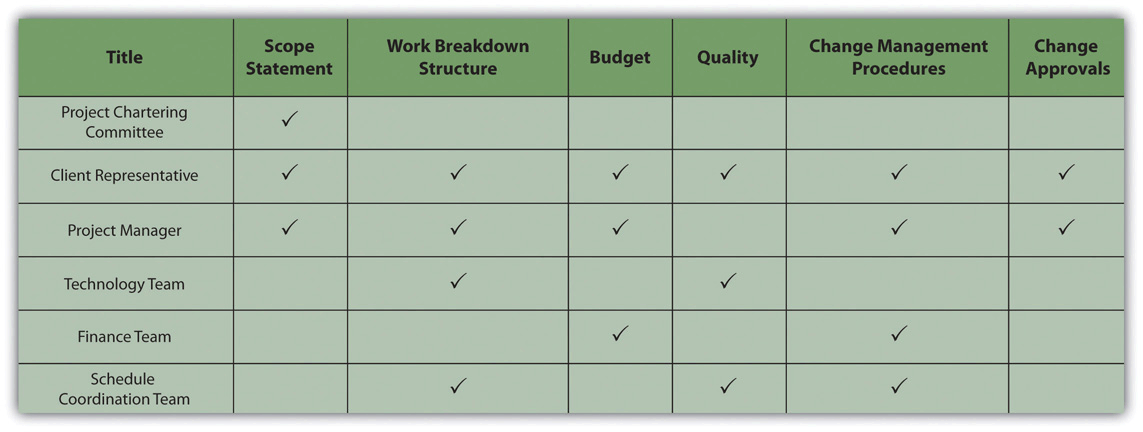Visit Audio Recordings for the audio version of this section.
LEARNING OBJECTIVES
- Describe the differences between communications in an existing organization compared with a new project.
- Describe how the detail of the communications plan is related to the complexity of the project.
- Describe a communication matrix and its function.
- Describe conventions for naming files to indicate their content and the version.
When a person joins an existing organization, one of the early tasks is to learn the work processes of the organization, including where to find information, the meeting schedule, and what reports are required. In existing organizations, new members discover the gatekeepers of information: those persons in the organization who know how to generate or find information. Typically, the generation, flow, and storage of information reflects the organizational culture, and to effectively communicate in an organization, a person must be able to develop communication styles and processes consistent with that organization.

Projects do not have the advantage—or sometimes the disadvantage—of an existing organizational culture or communication structure. The project leadership team develops an understanding of the information needs of the various members and stakeholders of the projects and develops a communications plan that provides the right information, at the right time, to the right people.
The detail of the communications plan is related to the complexity level of the project. Highly complex projects require a detailed communications plan to assure that the information needed by the project team and stakeholders is both generated and distributed to support the project schedule and project decisions. Crucial information can be lost or delayed in a complex project if the communications plan is not functioning properly.
Communicating Priorities
During a project in Tennessee, the project management team was exploring ways to complete the project earlier to meet the changing requirements of the client. The team identified a number of actions that could create an earlier completion date. The plan required an early delivery of testing materials by, and the team visited the supplier’s senior management and agreed to pay a bonus for early delivery of the equipment.
Two weeks later, during a review of the project procurement team progress, the project manager discovered that the organization’s procurement department had delayed approvals needed by the supplier because the engineering design was not submitted in the required format. This action effectively delayed the project two weeks and reduced the possibility of the project team meeting milestone requirements for earning a bonus.
The organization’s procurement team did not understand the critical nature of this supplier’s contribution to an early completion of the project. All the information needed by the organization’s procurement team was in the meeting minutes distributed to the entire team. The procurement team did not understand the implications of their work processes, and the result was a delay to the project schedule and a reduction in client satisfaction and project profitability.
Effective communication on a project is critical to project success. The Tennessee project is a typical example of errors that can be created by the breakdown in communication flow. Highly complex projects require the communication of large amounts of data and technical information that often changes on a frequent basis. Even when the information is at the right place and at the right time, the project procurement leader must assist the procurement team in understanding the priorities of the project. On large, complex projects, that procurement lead would not be in the daily communication to subcontractors or vendors. In the Tennessee project example, the procurement leader’s unique understanding that came from participation in the project leadership meeting required a more direct involvement with those subcontractors and vendors that impacted the project goals.
An effective project communications plan also does not overload team members and project systems with information that is not useful. Some project managers will attempt to communicate everything to the entire project team. Although this assures that each team member will receive critical information, the large influx of information can make the distillation of the information to the critical and relevant people more difficult for each team member.
Communication Matrix
A Guide to the Project Management Body of Knowledge (PMBOK) describes tools and techniques for identifying project stakeholders, defining their information requirements, and determining the appropriate communication technology. The project includes developing a list of all the people impacted by the outcome of the project and people who can influence the execution of the project, including project team members. The project leadership then generates a list of information needed or requested by each stakeholder.
The project leadership team develops a list of communication methods for gathering and communicating project information. These include a list of reports, meetings, and document flowcharts. The leadership team then typically develops a communication matrix that details who is included in each project meeting and the distribution of major documents in a table format.
Figure 7.4 Simple Communication Matrix

Document Control
On large, complex projects, organizing the creation, distribution, and storage of documents is a major and important activity. Organizations that execute a large number of complex projects will often have project document control systems that the project leadership team will adapt for their project. Document control systems distribute, store, and retrieve information that is needed by the project team. Documents originate from the various team members during the planning and execution of the work and then are transmitted to the document team for cataloging, distributing, and storing.
Document control systems have a systematic numbering system that allows a team member to derive information about the document through the document number.
Document Naming Provides Information about the Content
It is useful to have a unified system for naming documents which immediately provides content identification. For example, document names might indicate the category, purpose, author, and date via standardized codes that the project team adheres to. For example, a file named RFQ3.Monitors-Darnall-10.08.2012,rev3 lets team members instantly know this is a procurement document, which item was procured, who it was prepared by, when it was prepared, and what revision number it is.
When a document is expected to be revised over the course of the project, version control becomes important. Version control means labeling each revision which enables the team to understand the latest activity and status of the document (or the activity behind the document). For example, each drawing might be given a unique identification that reflects the type of drawing, the artist, and the version number. Because the design process includes several iterations of the drawings as more information is developed, document control uses an identification that indicates the version of the document. One procedure might be to use letters to indicate the version of the document until the document is approved and then use a number after approval. Therefore, a document with revision D will be the fourth version of the document. The same document with revision 3 means that this is third revision after the project was approved for construction.
To assure that everyone who should either review or approve the document received a copy, document control develops a distribution list for each type of document. Each person reviews and signs the distribution list and then sends the document to the next person on the list. The design documents, distribution lists, and other project documents are archived by document control for future reference. In the example above, the document was the third revision after the design was approved.
Naming conventions for files and the versions of files should be consistent with the practices of the parent organization or with the client organization so that the files may be archived with files from other projects.
KEY TAKEAWAYS
- In an existing organization, there are gatekeepers who know how to find information, when it is needed, and what reports are required. In a new project, the project manager can create a new flow of information and reporting requirements.
- More complex projects require more sophisticated communications plans.
- A communication matrix is a table that shows the names of people as column or row headings and the types of documents as row or column headings. In the cells where the name and document type intersect, a symbol indicates the person’s responsibility or access with regard to that type of document.
- File names can be used as codes to describe the contents of the file. Parts of the name can be used to identify the category, location, subject, author, and date. File name conventions should be used that match those used by the parent organization or by the client.
